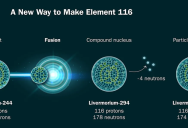Researchers Find New Method For Synthesizing Element 116, Which Opens The Door To Creating Brand New Element 120

Just about everyone will have studied the periodic table of elements at some point in their life.
These elements are the building blocks of everything in the universe, starting with hydrogen, which has just one proton in its nucleus, then helium with two, and so on all the way up.
Once you get to the higher numbers, you start seeing elements that are not actually found in nature (that we know of) and only exist because man created them.
Currently, the highest element on the periodic table is number 118, oganesson, which was first created in 2002.
The man made elements generally don’t last very long once created. Oganesson, for example, only has a half-life of less than half a millisecond, which makes it hard to study.
It is believed, however, that once scientists reach elements with a high enough number of protons in the nucleus, they will start to become stable again, which is one of the things that drives further research.
According to a new paper posted to arXiv and submitted to the journal Physical Review Letters, we might be getting a new element relatively soon.
Researchers are working on a way to bombard californium-249 (element 98) with a vaporized form of titanium (element 22).
The paper is serving as proof that the method they want to use can be effective. They were already able to create Livermorium (element 116) by bombarding plutonium (element 94) with the vaporized titanium.

According to a statement from the researchers:
“We’re very confident that we’re seeing element 116 and its daughter particles. There’s about a 1 in 1 trillion chance that it’s a statistical fluke.”
They went on to explain why proving this method with plutonium was necessary:
“It was an important first step to try to make something a little bit easier than a new element to see how going from a calcium beam to a titanium beam changes the rate at which we produce these elements. When we’re trying to make these incredibly rare elements, we are standing at the absolute edge of human knowledge and understanding, and there is no guarantee that physics will work the way we expect. Creating element 116 with titanium validates that this method of production works and we can now plan our hunt for element 120.”
The team at the university will need to make some adjustments to their equipment and then begin the potentially long process of bombarding the elements until they get the predicted results.
They say that it may take up to 10 times longer to produce.
If accomplished, it will create element 120. This element is not expected to be stable, but it is another step on the path toward potential new elements that may be stable and useful in the future.
To learn more about the as yet undiscovered elements, consider watching this interesting video:
Creating new elements is all in a day’s work for these scientists.
If you thought that was interesting, you might like to read about the mysterious “pyramids” discovered in Antarctica. What are they?

Sign up to get our BEST stories of the week straight to your inbox.




